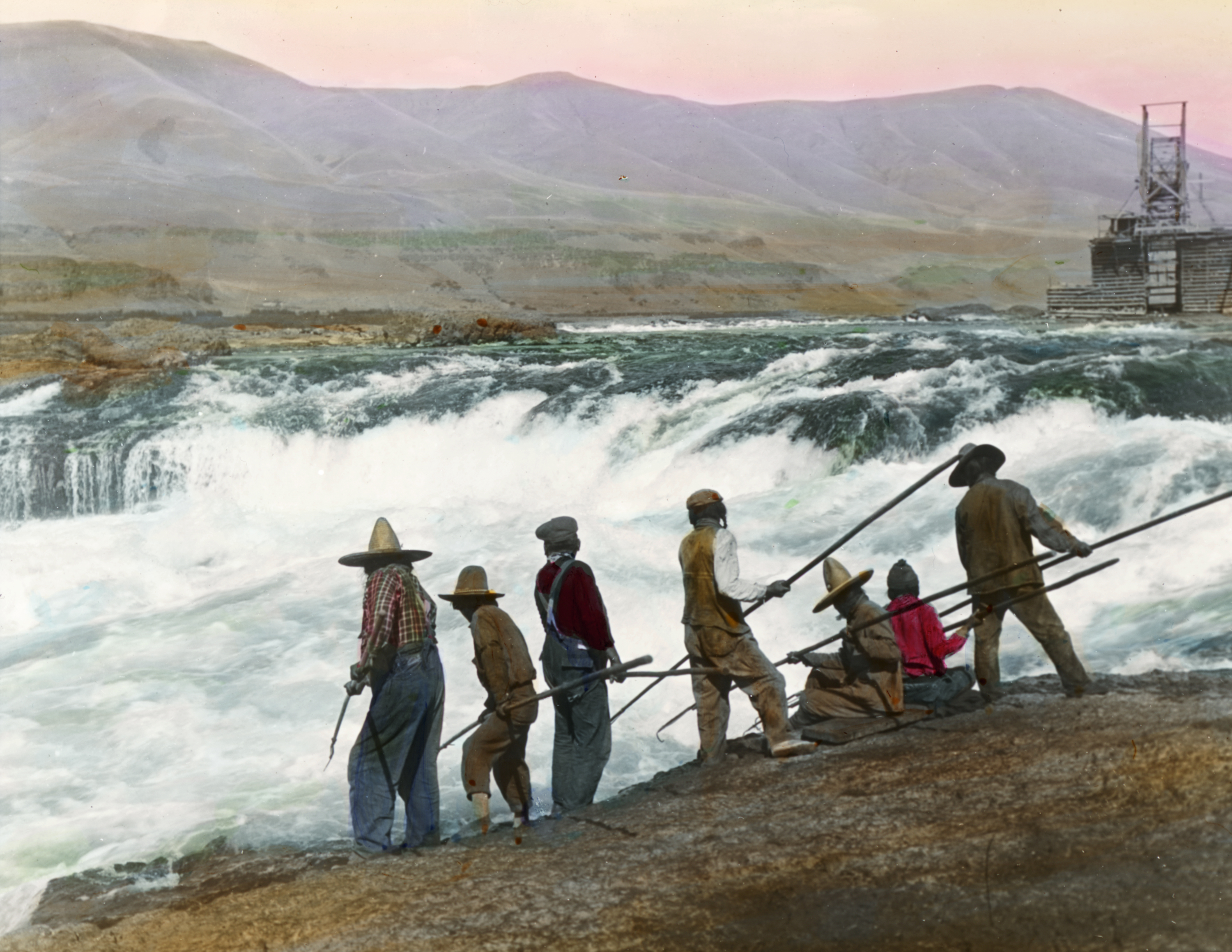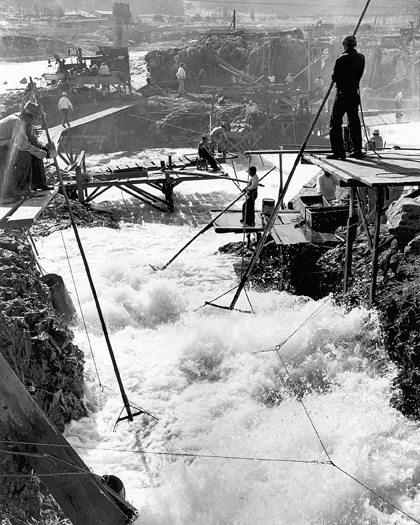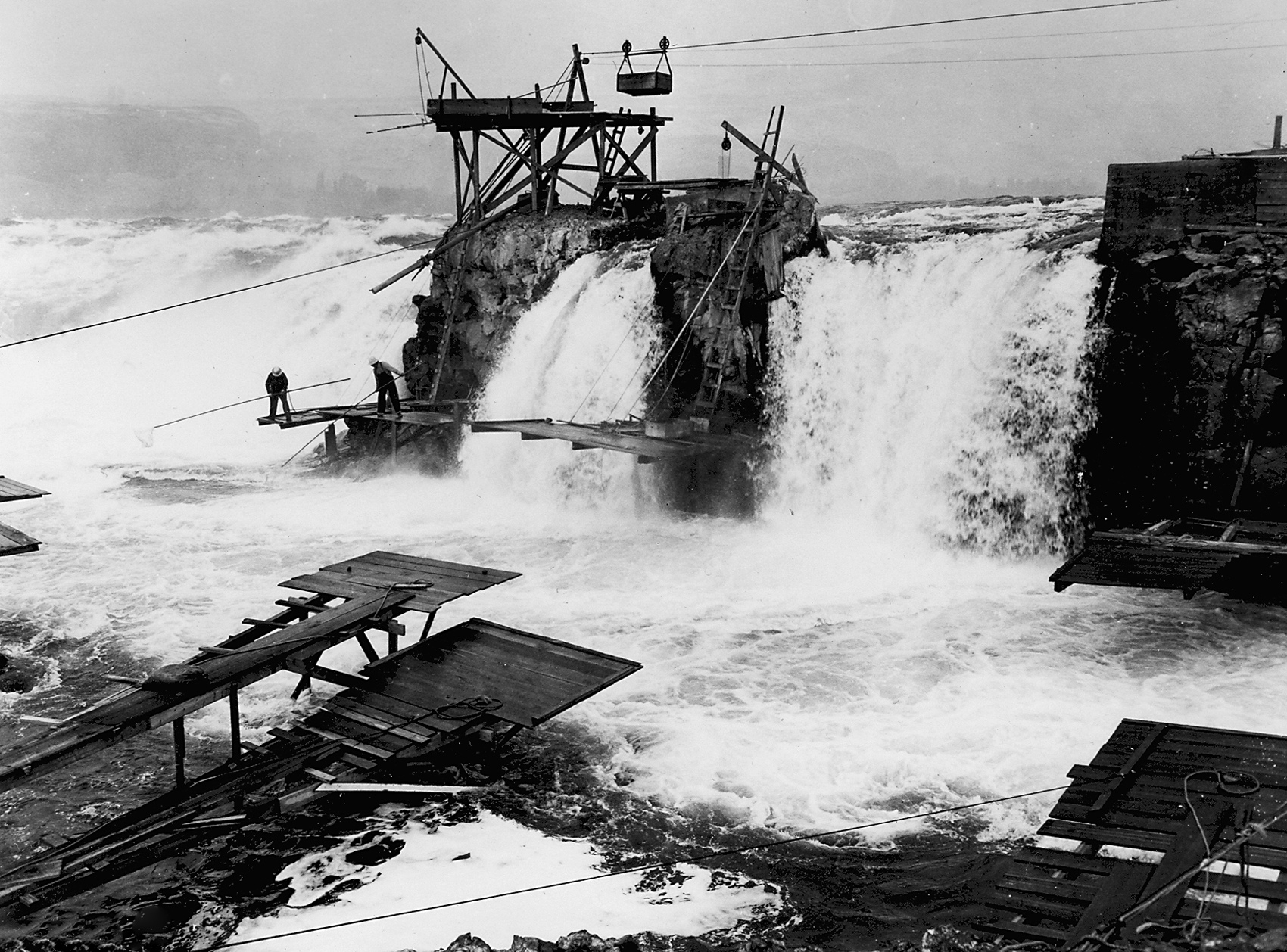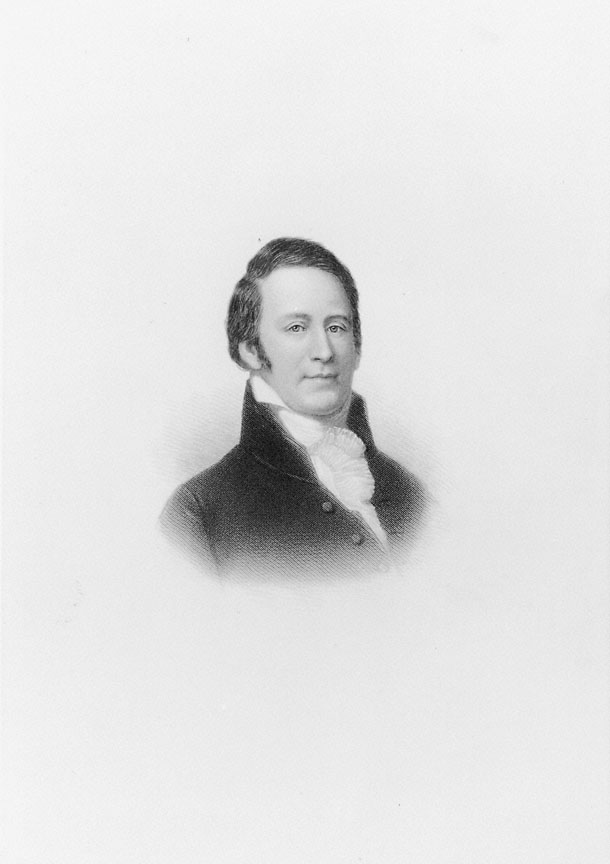Sk’in was a significant Native American settlement located on the north side of Celilo Falls near the present town of Wishram, Washington. Its name—the Columbia River Sahaptin word for “cradleboard”—referenced a prominent rock formation above the falls that resembled the device traditionally used to carry children.
According to tribal oral tradition, the trickster Coyote once disguised himself as a baby in order to fool five sisters who had selfishly dammed the river and stopped the upstream migration of salmon. The sisters adopted Coyote after finding his cradleboard floating on the water, only to have him break the dam while they were away digging roots. He then transformed the sisters into swallows, whose appearance each spring heralds the arrival of the salmon, and turned the cradleboard to stone. In a way, this account of Coyote’s triumph foreshadowed the destruction of Sk’in when Celilo Falls was buried by The Dalles Dam in the mid-twentieth century.
At the time of the upriver journey of the Lewis and Clark Expedition in April 1806, Sk’in contained 19 lodges housing roughly 600 people. The explorers called them “Eneshur,” a term of uncertain derivation and meaning, but village residents likely identified themselves as Sk’in-łá-ma ‘the people of Sk’in’. Not a tribe in the modern sense of the word, the people of Sk'in formed one of many independent, self-governing communities in a regional social network linked by shared territory and culture, trade, and intermarriage.
Sk’in had close ties to Wapáykt, located just downstream; Qmił, about thirty miles upriver in Rock Creek Canyon; and Wayám, on the south side of Celilo Falls near present-day Celilo Village. Although they recognized separate headmen, the inhabitants of Sk’in and Wayám intermarried so frequently that Chief William Yallup later described them as “one big family.” U.S. officials employed the Columbia as a dividing line, however, and separate treaties made in 1855 assigned the Sk’in-łá-ma to the Yakama reservation in Washington and the Wayám-łá-ma to the Warm Springs reservation in Oregon. Many refused to go anywhere.
During what is known as the Yakima War (1855-1858), which erupted after the treaty councils with the U.S. government, some warriors from Sk’in fought the Americans while others tried to remain neutral. Among the latter was Meninock, the headman who had signed the treaty with the United States government on behalf of the “Skin-pah” band of the Yakama people; U.S. troops burned his village nonetheless. Some people came back to rebuild Sk’in, and the community survived until The Dalles Dam flooded the area in 1957.
In the interim, Chief Yallup served as a spokesman for the nonreservation Columbia River Indians. He appointed Rock Creek’s delegate to the Celilo Fish Committee and supported Chief Tommy Thompson’s efforts to enforce traditional rules at the fishery. In 1945, Yallup even issued a statement declaring his people’s independence from the reservation-based tribal councils. By the time of Yallup’s death in 1955, most residents of Sk’in had relocated and enrolled in one of the recognized tribes. Celilo Village remained, though, and their shared history demonstrates the persistence of off-reservation Indian communities long after the treaties and wars of the nineteenth century.
-
![]()
Map of "E-nee-sher Nation" by William Clark, 1805, the site of what became known as Sk'in..
Courtesy Missouri Historical Soc., Moulton's Lewis and Clark Journals.
-
![Fishing at Celilo Falls.]()
Celilo Falls, fishing at, colorized, Picture 008.
Fishing at Celilo Falls. Oreg. Hist. Soc. Research Lib., OrHi 7784
-
![Celilo Falls dipnetters, 1954]()
Celilo Falls dipnetters, 1954.
Celilo Falls dipnetters, 1954 Courtesy Oreg. Hist. Soc. Research Lib., cn007237
Related Entries
-
Celilo Falls
Celilo Falls (also known as Horseshoe Falls) was located on the mid-Col…
-
![Columbia River]()
Columbia River
The River For more than ten millennia, the Columbia River has been the…
-
![Lewis and Clark Expedition]()
Lewis and Clark Expedition
The Expedition No exploration of the Oregon Country has greater histor…
Related Historical Records
Map This on the Oregon History WayFinder
The Oregon History Wayfinder is an interactive map that identifies significant places, people, and events in Oregon history.
Further Reading
Aguilar, George W. Sr. When the River Ran Wild! Portland, Ore.: Oregon Historical Society Press, 2005.
Fisher, Andrew H. Shadow Tribe: The Making of Columbia River Indian Identity. Seattle, Wash.: University of Washington Press, 2010.
Hunn, Eugene S. "Sk'in: The Other Side of the River." Oregon Historical Quarterly 108 (Winter 2007): 614-23.
Hunn, Eugene S., with James Selam and Family. Nch’i-Wána, “The Big River”: Mid-Columbia Indians and Their Land. Seattle, Wash.: University of Washington Press, 1990.






